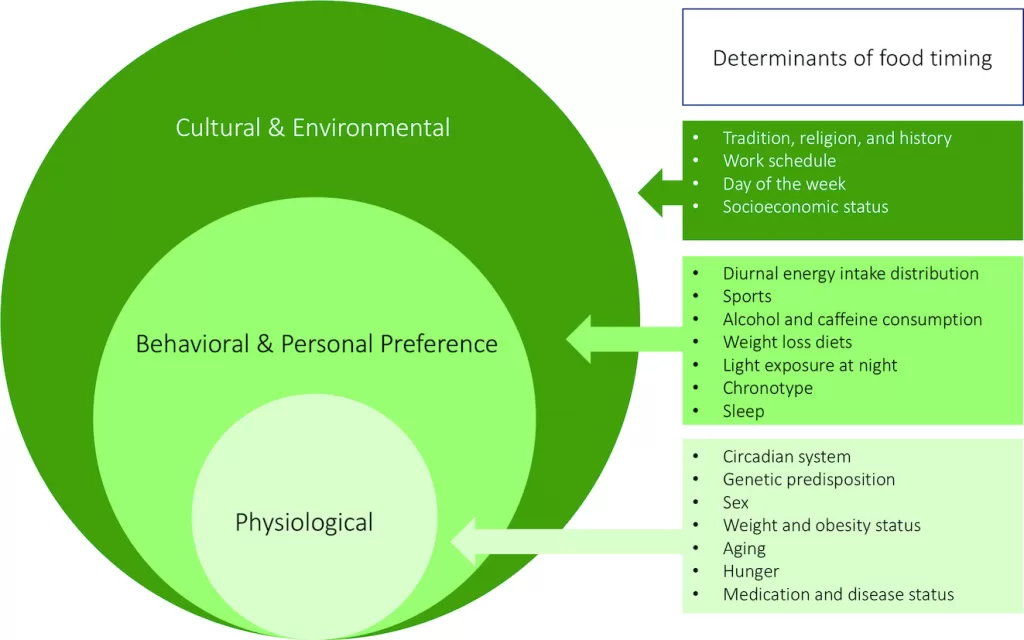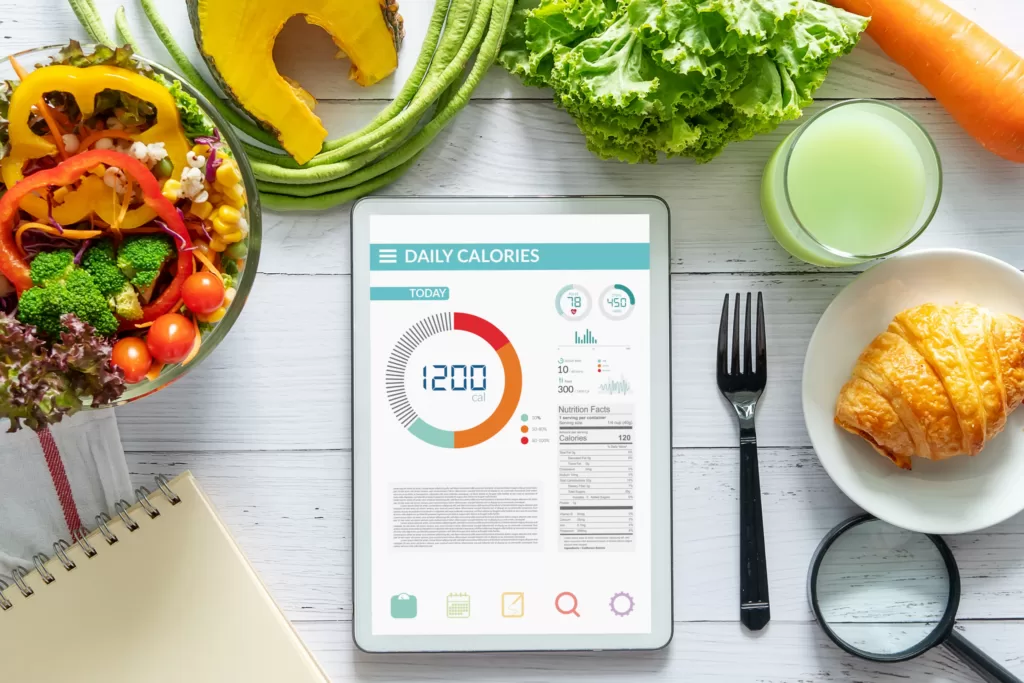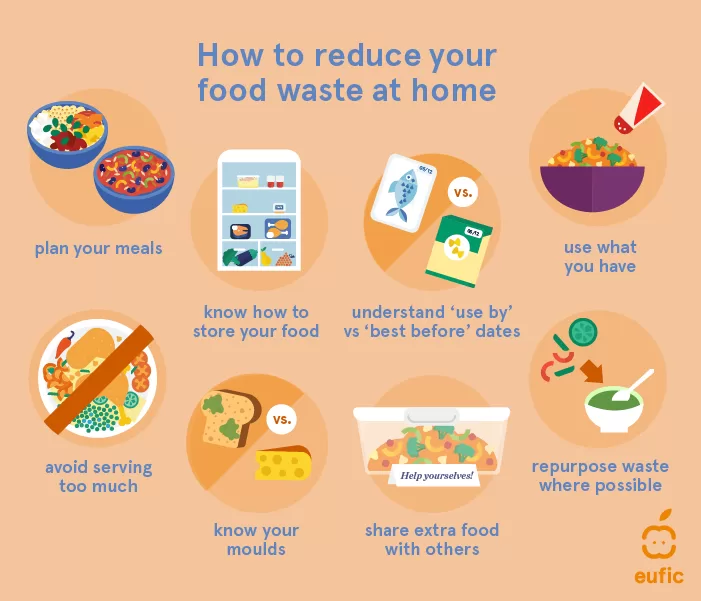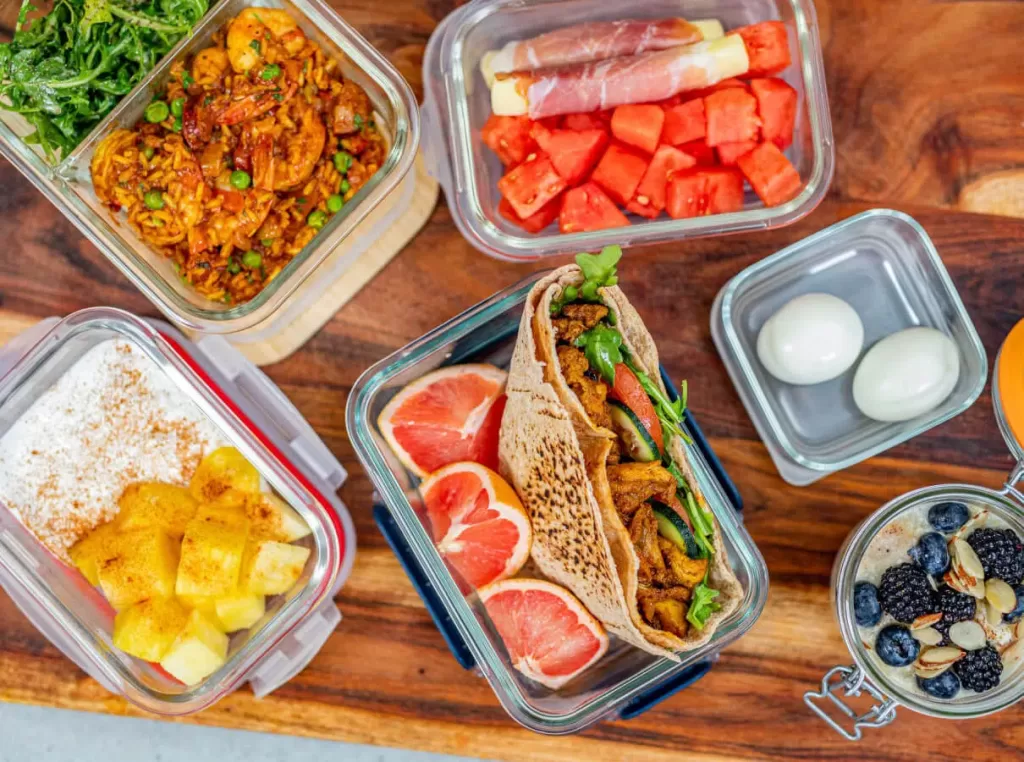INTRODUCTION
Food and the culture surrounding it have always been integral to human life globally. Food is not only a source of nourishment but also a marker of identity, tradition, and community. With rising health issues and growing awareness about healthy and conscious consumption, meal scheduling has become equally important. This can be approached by timed eating and food waste reduction, which are critical aspects of sustainable well-being.
The way we eat has always been measured by “what” and “how much” we consume. It’s time to also question “when” we eat. Timed eating is increasingly considered an influential factor in metabolic health, weight management, and sustainability outcomes. Correlating eating patterns with biological rhythms improves overall well-being and reduces food waste. This dual benefit supports both SDG3: Good Health and Well-Being and SDG12: Responsible Consumption and Production, aligning with the THRIVE Framework’s focus on timing, resources, and engagement.
On a pressing note, food security and equity remain urgent global priorities. SDG1: No Poverty calls for ending poverty in all its forms, recognising that financial hardship limits access to essential resources such as nutritious meals. SDG2: Zero Hunger aims to end hunger, achieve food security, and promote sustainable agriculture, emphasising the need for equitable access to food. Reducing food waste and adopting mindful meal scheduling directly contribute to both these goals by ensuring resources are used more efficiently and more food reaches those in need. This highlights how individual choices connect to systemic changes. The following sections further dive into these interlinked themes in greater depth.
WHY TIMING YOUR MEALS MATTERS
The timing of food intake is an emerging aspect of nutrition as it influences metabolic health. Eating late in the day, whether a delayed lunch or dinner, is linked to poorer weight-loss outcomes and a higher risk of obesity (Liu et al., 2024). When people consume a low-energy breakfast but a high-energy dinner, metabolic markers tend to worsen, increasing long-term disease risk. Meal timing is not just an individual choice but includes other associated factors like biological rhythms, work schedules, cultural practices, and social environment (St-Onge et al., 2022).

Source: Dashti et al., 2019
Studies led by researchers with simulated night-shift conditions highlighted the risks of untimed eating. Under controlled experiments, participants who ate meals showed worse glucose tolerance than those who fasted (Centofanti et al., 2024). This demonstrates how mistimed eating disrupts circadian rhythms and compromises metabolic health. In practice, aligning meal times with natural circadian patterns can help shift workers and others with irregular work schedules maintain better metabolic health.
HEALTH BENEFITS OF STRUCTURED EATING
It is confirmed now that scheduled eating and time-restricted patterns improve key health markers. A recent meta-analysis found that timed eating and structured meal scheduling were associated with greater weight loss, reduced BMI and waist circumference, and improvements in blood glucose and lipid levels (Liu et al., 2024).
For Type 2 Diabetes patients, the timing of the first meal is particularly important. An earlier start to eating improved metabolic responses across the day, while delaying breakfast worsened postprandial glucose control. This indicates that consistent meal schedules packed with loaded energy earlier in the day are more beneficial than sporadic late meals. Research on circadian nutrition suggests that stable eating windows regulate appetite hormones, reduce overeating, and maintain energy balance (Bravo-Garcia et al., 2024).
“The way we eat represents our most profound engagement with the natural world.” – Michael Pollan.
REDUCING FOOD WASTE WITH MEAL PLANNING
Beyond health, meal scheduling plays a crucial role in sustainability. Households are major contributors to global food waste. Over 7.6 million tonnes of food are wasted annually in Australia (End Food Waste Australia, 2023). The key driver of this waste is poor food planning owing to unstructured shopping, impulse purchases, and irregular diet routines.

Source: Instacart, 2022
Structured meal planning significantly reduces household waste by accounting for package sizes and dietary constraints. Families are less likely to let perishable items spoil by aligning purchases with planned, conscious consumption. Health-focused meal planning naturally leads to less food waste compared with approaches motivated only by sustainability messaging (University of Adelaide, 2025). This suggests that structured eating could be a powerful tool to promote both health and environmental sustainability. For example, households can start small by planning three to four dinners each week, which balances flexibility and intentionally reducing excess shopping and food waste.
HOW TO REDUCE FOOD WASTE: ANALYSIS AND SOLUTION
Food Waste Index Report 2021 mentions that approximately 931 million tonnes of food are wasted each year across the food service, retail, and household sectors. Households alone account for nearly 570 million tonnes, becoming the single largest source of avoidable waste. This roughly equates to 74 kilograms of food wasted per person per year globally (United Nations Environment Programme [UNEP], 2021).
Case studies across Australia further indicate the value of food planning. Reducing household waste should be a top priority. The first step towards that is proper meal scheduling and food preparation. This gives an idea of how planned consumption relates to actual food usage. While there is no specific dataset estimating exactly how much waste could be reduced by adopting structured food scheduling, a normative sensitivity analysis using the Food Waste Index Report 2021 provides insight.
| Income Group | Individuals | Waste (kg) | Goal (kg) | % Reduction Needed | Adjusted Individuals |
| High-income countries | 1000 | 79 | 50 | -36.71% | 633 |
| Upper-middle income countries | 1000 | 76 | 50 | -34.21% | 658 |
| Lower-middle income countries | 1000 | 91 | 50 | -45.05% | 550 |
The analysis shows that to reach a target of 50 kg waste per capita annually, 550–658 out of 1000 individuals would need to reduce their personal waste by 26–41 kg. This demonstrates how individual behaviour at a small household can collectively play an important role in achieving global waste reduction targets.
The above findings indicate the reason behind households contributing disproportionately to overall food waste. Irregular shopping, improper meal planning, poor storage, and cultural preferences all drive unnecessary food disposal. End Food Waste Australia (2023) concluded that flexible meal plans, portion control awareness, and proper food storage as interventions to help households save money and reduce waste.
TOOLS AND APPS FOR Meal Scheduling
Technology now offers innovative solutions to support meal scheduling, food planning, and waste reduction, representing the THRIVE Framework Foundational Focus Factor of Value-Based Innovation. Smartphone apps such as Mealime, and Paprika allow users to plan weekly menus, generate shopping lists, and track expiry dates. Other applications like NoWaste and Fridge Pal assist users in managing kitchen inventories, monitoring quantities and expiration dates, and even weighing ingredients. By logging meals and tracking calorie intake, these tools help individuals align their diet with health goals.
Apps designed for sustainability, such as OLIO, Too Good To Go, and Food Rescue, encourage mindful consumption by connecting households with local food-sharing networks or surplus food discounts, lowering environmental impact and fostering a sense of community. More comprehensive apps like MyFitnessPal and Cal AI integrate calorie tracking, nutritional guidance, and meal logging, enabling users to monitor their intake, plan balanced meals, and make informed decisions. Emerging AI-powered diet planning tools, such as Nutrino, offer personalised meal suggestions and automated nutritional coaching based on users’ health goals, allergies, and even seasonal availability, making sustainable and health-focused eating more accessible than ever.

Source: Kim Abbage Hart, 2025
While using these apps may feel time-consuming and overwhelming initially, particularly during busy weekdays, developing a diet routine in the long run helps users streamline meal tracking, declutter their minds, promote conscious consumption, and confidently progress toward better health and more sustainable food practices.
SUSTAINABLE FOOD CHOICES THROUGH TIMING
Scheduling meals intersects closely with sustainable eating. A simple thought of when perishable foods such as fresh produce, dairy, or bread will be consumed can reduce spoilage. Having fresh produce earlier in the week and saving frozen or preserved items for later ensures that nothing goes to waste. Timed eating practices, such as allocating specific days for leftovers, can be a good, sustainable practice, valuing every meal prepared.
Some people think that storing leftovers, meal prepping in advance, or reheating food may be unsafe or destroy all the valuable vitamins and minerals. In fact, when food is cooled promptly, reheated to safe temperatures, and handled properly, it is safe to consume (NSF International, 2024; WebMD, 2024). While it is partly true that certain heat-sensitive vitamins, like vitamin C and some B vitamins, can degrade with repeated heating, most nutrients, especially minerals, remain intact. Practising safe storage and reheating not only helps retain nutritional value but also extends the usability of meals, reduces food waste, and saves time.
Meal prepping is an efficient strategy for working professionals. There is a misconception that it can lead to food waste, usually because people worry that pre-prepped meals might spoil or go uneaten. However, research shows that when meal prepping is done correctly through safe storage, portioning, and intentional use of ingredients, it can actually reduce household food waste. For example, structured preparation helps manage portion sizes, optimise ingredient use, and ensure leftovers are incorporated into later meals, ultimately saving both time and effort (Stancu et al., 2016; WRAP, 2013; UNEP, 2021).
KEY BENEFITS OF MEAL PREPPING
- Reduction in food waste: Pre-prepared meals and scheduled ingredient use ensure fewer items spoil (Quested et al., 2013).
- Time and cost efficiency: Reduces weekday cooking time and unnecessary shopping, lowering food waste and grocery costs (Public Health England, 2020).
- Improved nutritional intake: Careful meal planning can enhance nutritional intake by promoting balanced diets and decreasing dependence on processed foods (Ducrot et al., 2020).
- Mental preparedness and routine: Categorising meals reduces decision fatigue and increases adherence to planned consumption (Cheatmeal, 2025).

Source: EUFIC,2021
TIPS FOR MEAL SCHEDULING AND PREPPING
1. PLAN WEEKLY MENUS
Dedicate time each week to plan meals, considering both nutritional balance and ingredient perishability. Front-load energy earlier in the day to support metabolic health (Liu et al., 2024).
2. BATCH COOK STRATEGICALLY
Prepare staple foods like grains, legumes, and proteins in advance and portion them for the week.
3. SCHEDULE AND INCORPORATE LEFTOVERS
Allocate specific days to consume leftovers, reducing waste and saving cooking time.
4. PROPER STORAGE AND EXPIRY TRACKING
Store prepped meals in airtight containers and label them with preparation or expiry dates. Keeping perishables visible encourages timely consumption and reduces food waste (FoodSafePal, 2023).
5. MAINTAIN A SHOPPING LIST
Base shopping strictly on planned meals to avoid overbuying and duplication.
By integrating these strategies, households can align timed eating with sustainable consumption, achieving both health and environmental benefits.

Source: Curry, 2022
A THRIVABLE FRAMEWORK
The United Nations’ Sustainable Development Goals (SDGs) provide a global framework for promoting health, well-being, and responsible resource use. In the context of food, as mentioned earlier, SDG 1: No Poverty and SDG 2: Zero Hunger highlight the importance of ensuring equitable access to nutritious food and reducing vulnerabilities linked to food insecurity. Alongside this, SDG3: Good Health and Well-Being emphasises healthy eating habits, while SDG12: Responsible Consumption and Production focuses on reducing food waste and promoting mindful consumption. Structured meal planning, timed eating, and conscious food preparation directly support these goals. In line with this, the THRIVE Framework goes further to provide a practical, value-based approach to derive interventions that are both sustainable and impactful. Its principles of Values-Based Innovation, Regenerative Economy, and Systems Thinking align closely with the concept of meal scheduling, which are as follows.
Values-Based Innovation translates thrivable intentions into innovative, practical meal-prepping habits that deliver long-term health and environmental benefits. It encourages actionable strategies that make meal prepping a meaningful lifestyle practice rather than just a routine.
The Regenerative Economy principle emphasises the responsible reduction in food waste and restoring the value of the resources used. This includes planning meals to minimise waste, using ingredients efficiently, and creatively repurposing leftovers. These practices show how everyday food choices can contribute to a healthier, more resilient food system.
Systems Thinking promotes a holistic perspective. It highlights the interconnected impacts of meal choices on health, household waste, and the wider environment. It encourages individuals to consider the links between meal timing, nutritional balance, and broader ecological outcomes. This ensures that household-level decisions also support larger societal and environmental objectives.
By integrating THRIVE principles with SDG objectives, households can adopt sustainable eating practices that are more feasible and rewarding in daily life.
CONCLUSION
The timing of food consumption is emerging as a vital yet underutilised strategy for boosting health and reducing food waste. Structured meal schedules enhance metabolic health, stabilise appetite, and improve energy balance, while also ensuring food is used efficiently. By combining scientific insights with practical tools, meal scheduling empowers individuals and families to embrace more thrivable, healthier lifestyles.
“We need to move from an age of plenty to an age of sustainability, where wasting food is no longer acceptable.” – Ban Ki-moon.
With rising obesity and food waste, adopting simple meal scheduling can offer an evidence-based pathway to thrive personally and collectively. Discover more such insights on the THRIVE Project website, where you can access articles, whitepapers, podcasts, webinars, and interactive workshops. These resources offer practical, evidence-based guidance for individuals, professionals, and communities aiming to foster healthier, more thrivable environments.























